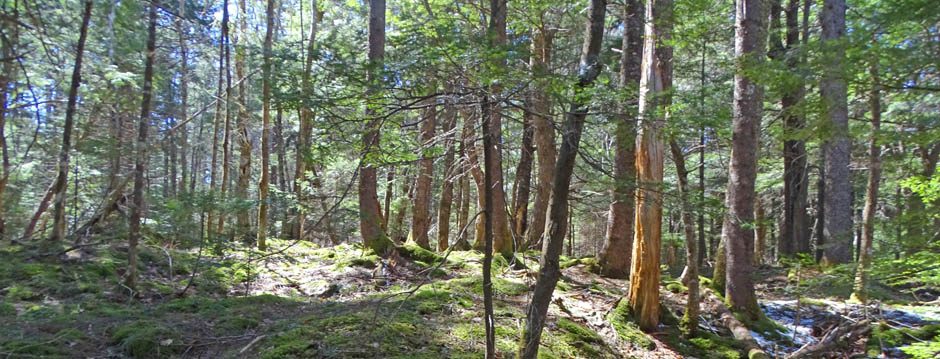These items were posted under Perspectives on nsforestnotes.ca. They include links to the Natural Resources Strategy, a review process carried out 2008-2010. The original links were to items on the government’s novascotia.ca website but as of July 10, 2022 (and presumably earlier) these were no longer functional and it seems the documents have been removed. However, most of these important historical materials, asterisked below, are available on the Web Archive.
———–

NSDNR Minister MacDonell at rally on oct 29, 2010: “There’s gonna be a reduction in clearcutting in Nova Scotia.” View video
Restoring the Health of Nova Scotia’s Forests
A panel of expertise report on forests by Bob Bancroft and Donna Crossland to the steering panel for the Nova Scotia *Natural Resources Strategy 2010 process. This report was widely applauded, the *Steering Panel adopted most of their recommendations, and then NDP Minister of Natural Resources John MacDonell promised fundamental change.[Article in CH, not available] He released a set of “*strategic directions” which included a commitment to “Reduce the proportion of wood harvested by the clear cut method to no more than 50% of all forested lands over a five-year period”. Within months, however, Premier Dexter shifted MacDonell to another Dept. and the Bancroft/Crossland Report was tacitly shelved in favour of an alternative, industrial forestry-oriented *Report by Jon Porter. The province was still committed to the 50% target for clearcutting but introduced a *definition of clearcutting that effectively allowed a lot of what is functionally a clearcut not to be counted as a clearcut. Four years later the new Liberal government hired Jon Porter as the executive director of the NSDNR’s Renewable Resources Branch [Archived Chronicle Herald Article] In August of 2016 (the year clearcutting was to have been reduced to 50% of all cuts), the province issued a *five-year Progress Report on the 2011-2020 Natural Resources Strategy in which they announced that the 50% target was irrelevant because “We have now developed tools that ensure that all harvest treatments are aligned with the nature-based requirements of Nova Scotia’s lands.” The return to same old same old was complete. Regardless of the history subsequent to the Bancroft/Crossland report, their report still says a lot about the current state of our forests (just add 6 more years of extensive clearcutting and the “biomess”) and where we should be headed. Also see the *Research Addendum. See also Natural Resources Strategy Summary by Richard Beazley (2017); When is a Clear Cut not a Clear Cut? (Miles Howe for Halifax media coop nov 25, 2011); comments by Donna Crossland Apr 13, 2011/
Comments on the Phase II Recommendations related to Forestry and a Critique of the Review of those Recommendations by Dr. Robert G. Wagner
David G Patriquin, July 27, 2010. The Forest Products Association of Nova Scotia (now known as Forest Nova Scotia) did not like the conclusions of Restoring the Health of Nova Scotia’s Forests (above), and hired* Dr. Robert G. Wagner, Director of the University of Maine’s School of Forest Resources, to review it. He submitted a confidential report titled Review of Reports and Recommendations Relating to Forests/Forestry as Part of Phase II of Nova Scotia’s Natural Resources Strategy Development Process on July 7, 2010, which was forwarded to government.** I was given a copy of that report and reviewed the review which I also submitted to government and made public. Unfortunately Forest Nova Scotia has still not made Wagner’s report public, a sad comment in itself as was Wagner’s report.
*Reportedly paid in the 6-digit range.
**While confidential, it was, apparently, used as the basis of FPANS’s PR campaign with members to cast the *Natural Resources Strategy Phase II Recommendations as “not based on credible science and come from people who would prefer to see our industry die”. View the EAC Response to Forest Industry Campaign against Steering Panel Report (July 11, 2010). Macdonnell was evidently not persuaded by the numerous letters he received (re comments on Oct 29, 2010), but he didn’t have Premier Dexter’s back and was moved to another portfolio in early 2011.
In Search of Compass and Gyroscope: Where were Adaptive Management and Principled Negotiation in Nova Scotia’s Forest-Strategy Process
By Peter Duinker, Dalhousie Law Journal 70, p 55-70 (2012). (Only the abstract is available to the public). Prof Duinker is highly critical of the “the process used to develop Nova Scotia’s Natural Resources Strategies of August 2011, specifically the forest strategy” and cites the Wagner review (see above) as evidence that it didn’t work. It is remarkable to me that an academic would cite an unpublished and inaccessible document commissioned by a party that clearly did not like the outcome of the process as an “independent peer review” and cite it so uncritically as evidence that process did not work, a point apparently missed by any reviewers. I wouldn’t list it here were it not that Prof Duinker is one of the experts hired by the Independent Review of Forestry in NS that is being conducted Aug 30 2017-Feb 28, 2018 (see Post of Nov 29, 2017 for some further comments).
